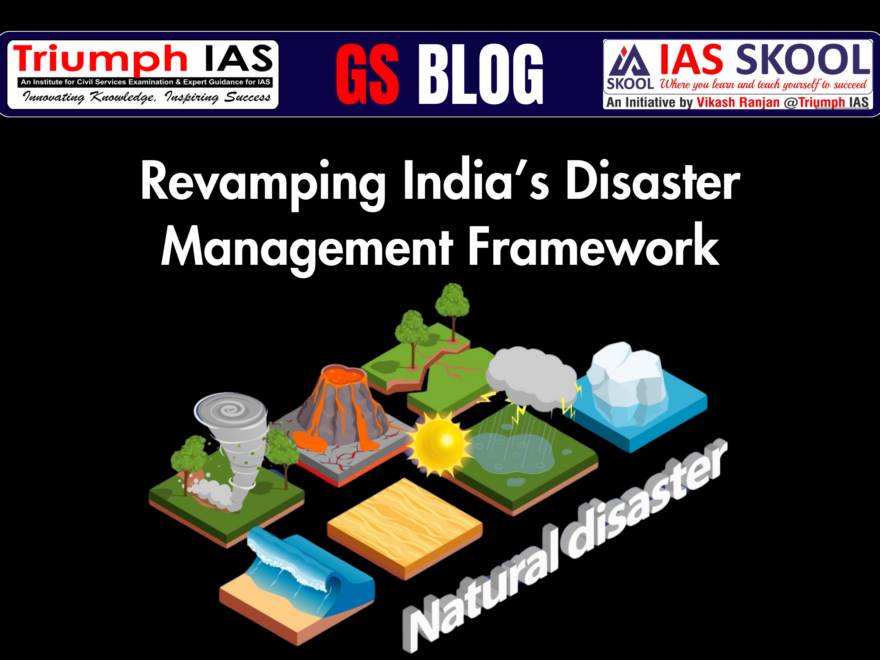Revamping India’s Disaster Management Framework
Almost two decades after the catastrophic 2004 Indian Ocean Tsunami, which claimed over 230,000 lives, India has significantly overhauled its disaster management strategies. The enactment of the Disaster Management Act in 2005 led to the formation of the National Disaster Management Authority (NDMA) and the National Disaster Response Force (NDRF), elevating the nation from a disaster-stricken victim to a regional leader in disaster preparedness. However, India’s extensive coastline, diverse terrain, and increasing climate-related vulnerabilities highlight the need for sustained efforts, continuous innovation, and enhanced disaster response mechanisms.
Evolution of Disaster Management in India
Early Years: Relief-Centric and Reactive Approach (Pre-1980s)
- Focus on Relief and Rehabilitation: In the post-independence era, disaster management efforts were primarily reactive, focusing on immediate relief measures like food distribution, temporary shelters, and medical aid.
- State-Centric Responsibility: Disaster management was largely the responsibility of state governments, with central assistance provided during major calamities.
- Challenges Exposed: Events like the Bihar famine (1966-67) and the 1972 drought revealed inefficiencies in relief distribution and the absence of preventive strategies.
Shift Towards Planning and Preparedness (1980s-2000s)
- Institutional Focus: The establishment of the Department of Environment in 1980 (later becoming the Ministry of Environment and Forests) began addressing disaster-related environmental issues.
- Impact of Major Events: The Bhopal Gas Tragedy (1984), one of the world’s worst industrial disasters, underscored the need for stringent safety regulations and industrial disaster preparedness.
Cyclones in Andhra Pradesh (1990) and the Latur Earthquake (1993) exposed gaps in relief coordination but still lacked significant emphasis on prevention and mitigation.
- Formation of Key Organizations: In 1990, the Cyclone Warning Directorate was created in New Delhi to coordinate cyclone warnings and serve as the Regional Specialized Meteorological Centre for Tropical Cyclones (RSMC-TC), providing regional guidance.
Institutionalization of Disaster Management (2000s)
- Turning Points from Disasters: The Bhuj Earthquake (2001) highlighted weaknesses in urban planning and infrastructure resilience, driving systemic reforms.
The Indian Ocean Tsunami (2004), which caused widespread devastation, marked a watershed moment in India’s disaster management approach.
- Disaster Management Act (2005): This landmark legislation institutionalized disaster management, creating a structured and comprehensive framework.
- The National Disaster Management Authority (NDMA) was established, along with State Disaster Management Authorities (SDMAs) and District Disaster Management Authorities (DDMAs).
- The focus shifted to the four pillars of disaster management: mitigation, preparedness, response, and recovery, ensuring a proactive and integrated approach to disaster risk management.

Proactive and Resilience-Focused Approach (2010–Present)
Shift to Mitigation and Resilience:
- India has shifted its focus to risk reduction, guided by global frameworks like the Hyogo Framework for Action (2005–2015) and the Sendai Framework for Disaster Risk Reduction (2015–2030).
- Emphasis is now on building long-term resilience rather than just responding to disasters.
Adoption of Technology:
Advanced technological solutions, including Doppler Radar systems, flood forecasting tools, and real-time data-sharing platforms, have enhanced disaster prediction and response capabilities.
Community-Centric and Inclusive Strategies:
- Initiatives such as Aapda Mitra train local volunteers to act as first responders during emergencies.
- School disaster management plans promote disaster preparedness and safety at the grassroots level.
Global Collaborations:
- India actively engages in international frameworks such as the SAARC Disaster Management Centre and the United Nations Office for Disaster Risk Reduction.
- Through participation in the Coalition for Disaster Resilient Infrastructure (CDRI), India collaborates on developing infrastructure that can withstand disasters.
Evolving Focus Areas:
Addressing Climate-Induced Disasters:
- With rising climate-related risks, India has integrated climate resilience into its disaster management plans.
- Nature-based solutions, such as mangrove restoration under programs like Namami Gange, are being implemented to mitigate flooding and protect vulnerable ecosystems.
Urban Disaster Management:
- Urban resilience is now a core component of development projects, especially under the Smart Cities Mission.
- Post-2022 floods in Bengaluru, flood management strategies have focused on wetland restoration and upgrading stormwater infrastructure to prevent future urban flooding crises.
Major Disaster Challenges Confronting India
- Escalating Climate-Induced Disasters:
- India is witnessing an increasing frequency of extreme weather events due to climate change, exposing gaps in its mitigation frameworks.
- Cyclone Mocha (2023) caused significant damage in the Sundarbans, while record-breaking rainfall in Himachal Pradesh (2023) resulted in losses exceeding ₹10,000 crore, exacerbated by deforestation and unregulated development.
- A study revealed that India faced extreme weather events on 314 of 365 days in 2023, highlighting the lack of climate-resilient infrastructure and increased human and economic vulnerabilities.
- Urban Flooding from Chaotic Urbanization:
- Rapid urbanization without sustainable planning has turned cities into hotspots for urban flooding.
- Developed cities have seen peak water levels rise by 1.8 to 8 times due to unplanned expansion.
- For instance, Chennai’s 2021 floods were driven by outdated drainage systems and illegal construction on wetlands, while Bengaluru’s 2022 floods were worsened by corruption and encroachments on lakes, stormwater drains, and buffer zones.
- Himalayan Fragility and Glacial Retreat:
- Melting glaciers and unstable Himalayan geology have led to high-magnitude disasters like landslides and glacial lake outbursts.
- The Kedarnath flood (2013) and Chamoli disaster (2021) revealed cascading risks from unchecked hydropower projects and deforestation.
- Between 1975 and 2000, Himalayan glaciers lost an average of 4 billion tonnes of ice annually, doubling to 8 billion tonnes per year between 2000 and 2016, threatening livelihoods and water security downstream.
- Industrial Hazards and Chemical Disasters:
- Lax enforcement of industrial safety norms has resulted in repeated industrial accidents.
- The Vizag gas leak (2020) exposed over 10,000 people to toxic fumes, while the Ludhiana gas tragedy (2023) highlighted the absence of real-time hazardous material monitoring.
- Government data shows that an average of three workers lose their lives daily in Indian factories, yet the implementation of NDMA’s chemical disaster guidelines remains fragmented, especially in Tier-2 and Tier-3 cities.
- Agricultural Vulnerabilities and Drought Risks:
- Erratic monsoons, heatwaves, and groundwater depletion are worsening drought conditions, crippling India’s agrarian economy.
- For instance, the 2022 Latur drought led to widespread crop failures in a region where over 60% of the population depends on agriculture.
- NITI Aayog estimates that 40% of Indians will have no access to drinking water by 2030. Despite initiatives like PMKSY (Pradhan Mantri Krishi Sinchayee Yojana), rainwater harvesting and irrigation infrastructure remain insufficient.
- Forest Fires and Loss of Carbon Sinks:
- Forest fires are becoming more frequent and intense due to climate change and human activities.
- The India State of Forest Report (ISFR) 2023 revealed that Uttarakhand alone recorded 5,351 forest fires between November 2022 and June 2023.
- Fires like the Simlipal blaze in Odisha (2021) lasted over 10 days, affecting nearly one-third of the area and causing significant ecological loss.
- Health Crises Following Disasters:
- Disasters often trigger public health emergencies due to disrupted sanitation, contaminated water supplies, and weakened healthcare systems.
- After the 2018 Kerala floods, outbreaks of waterborne diseases like leptospirosis and cholera surged.
- Limited deployment of mobile health units and slow response times expose critical gaps in disaster-related healthcare infrastructure.
- Weak Early Warning Systems and Coordination Failures:
- Despite technological advancements, gaps in last-mile connectivity hinder effective disaster response.
- A 2023 World Meteorological Organization (WMO) report ranked India 14th out of 21 countries in early warning system effectiveness, citing below-average performance in risk knowledge, forecasting, dissemination, and preparedness.
- Gendered and Social Inequities in Disasters:
- Disasters disproportionately impact women, children, and marginalized groups, exacerbating existing social inequalities.
- Following cyclones like Amphan and Yaas, vulnerable populations, especially women and children, faced heightened risks of trafficking and exploitation, worsening their recovery challenges.
- Gaps in Institutional Frameworks and Funding:
- India’s disaster management frameworks remain more reactive than proactive, with insufficient focus on mitigation.
- Of the ₹68,463 crore allocated for the National Disaster Risk Management Fund (NDRMF) from 2021–26, 80% is reserved for the National Disaster Response Fund, leaving just 20% for the Mitigation Fund.
- Weak institutional accountability and fragmented policies continue to hinder disaster risk reduction and resilience-building efforts.
Measures India Can Adopt to Enhance Disaster Resilience and Mitigation
- Strengthening Climate-Resilient Infrastructure:
- India must invest in infrastructure capable of withstanding extreme weather events such as cyclones, floods, and heatwaves.
- Priorities include constructing green buildings, flood-resistant urban drainage systems, and cyclone-proof housing in coastal areas.
- For instance, Odisha’s cyclone shelters have proven life-saving and can serve as a model for nationwide replication.
- Integrating the Smart Cities Mission with climate-resilience planning will ensure urban growth aligns with disaster mitigation goals.
- Implementing Community-Based Disaster Risk Reduction (CBDRR):
- Empowering local communities through training, capacity-building, and disaster preparedness exercises is crucial.
- Merging Mahatma Gandhi National Rural Employment Guarantee Act (MGNREGA) with community-led hazard mapping can result in sustainable assets like embankments and check dams.
- Integrated Water Resource Management (IWRM):
- A holistic approach to water management can tackle flooding and drought simultaneously.
- Measures include wetland restoration, urban rainwater harvesting, and strengthening river embankments.
- Linking Namami Gange with city-level flood prevention plans can mitigate urban flooding while enhancing river ecosystems.
- Modernizing Early Warning Systems with Technology:
- Leveraging advanced technologies like AI, IoT, and geospatial mapping can improve early warning systems.
- Expanding the Common Alerting Protocol (CAP) to deliver mobile alerts in local languages can strengthen last-mile communication.
- Utilizing ISRO’s satellite capabilities, combined with AI-powered models, will help monitor high-risk zones and improve response times.
- Retrofitting Seismic Zones and Enforcing Building Codes:
- Strict enforcement of seismic safety codes is necessary, especially in urban areas and high-risk zones like the Himalayas.
- Retrofitting vulnerable structures, such as schools and hospitals, will reduce casualties during earthquakes.
- Integrating these efforts with Pradhan Mantri Awas Yojana (PMAY) can ensure affordable housing complies with disaster-resilient norms.
- Scaling Up Insurance Coverage for Disaster Losses:
- Introducing microinsurance schemes tailored for farmers, small businesses, and vulnerable populations can mitigate post-disaster financial losses.
- Linking crop insurance under Pradhan Mantri Fasal Bima Yojana (PMFBY) with parametric insurance models can facilitate faster payouts.
- Disaster insurance integration within the financial inclusion agenda, such as through Jan Dhan accounts, can provide broader coverage in rural areas.
- Strengthening Urban Disaster Preparedness through the Smart Cities Mission:
- Urban centers must incorporate disaster management into development plans.
- Cities under the Smart Cities Mission should adopt risk-sensitive zoning, automated weather monitoring systems, and early warning mechanisms.
- For instance, Surat’s early flood-warning system has minimized damages during monsoons.
- Collaborating with startups under the Startup India scheme can foster innovations in urban disaster resilience technologies.
- Integrating Climate Change Mitigation with Disaster Risk Management:
- Aligning climate change strategies with disaster resilience through nature-based solutions is critical.
- Mangrove restoration programs, as implemented in the Sundarbans, can mitigate cyclone impacts and reduce flood damage while acting as carbon sinks.
- A global study found mangroves reduce flood damage by $65 billion annually.
The implementation of the Disaster Management Act of 2005, coupled with the adoption of the Sendai Framework for Disaster Risk Reduction, has bolstered India’s disaster preparedness and response mechanisms.However, challenges such as climate-induced disasters, urban flooding, and industrial hazards continue to pose significant risks. To address these issues effectively, India must transition from a reactive, relief-centric approach to a proactive, resilience-focused disaster management framework.
The End of the Blog- Revamping India’s Disaster Management Framework

|



















One comment